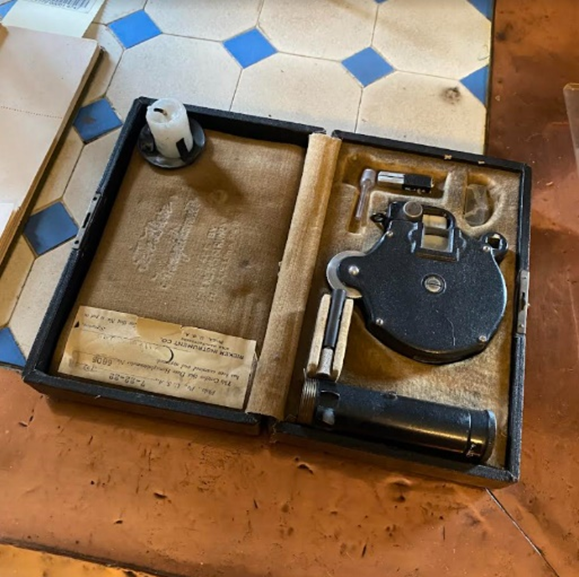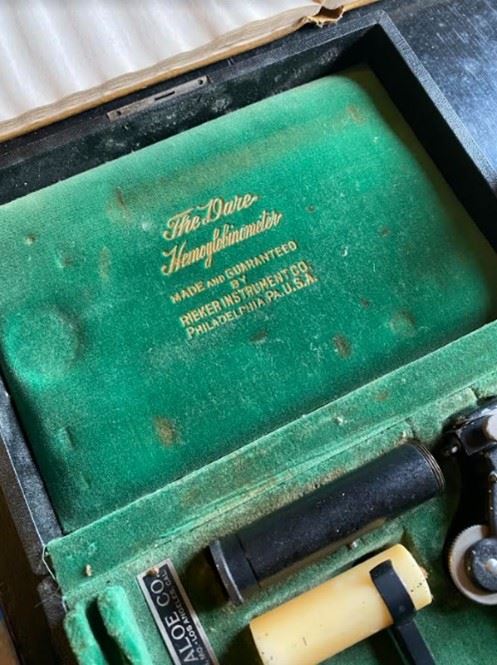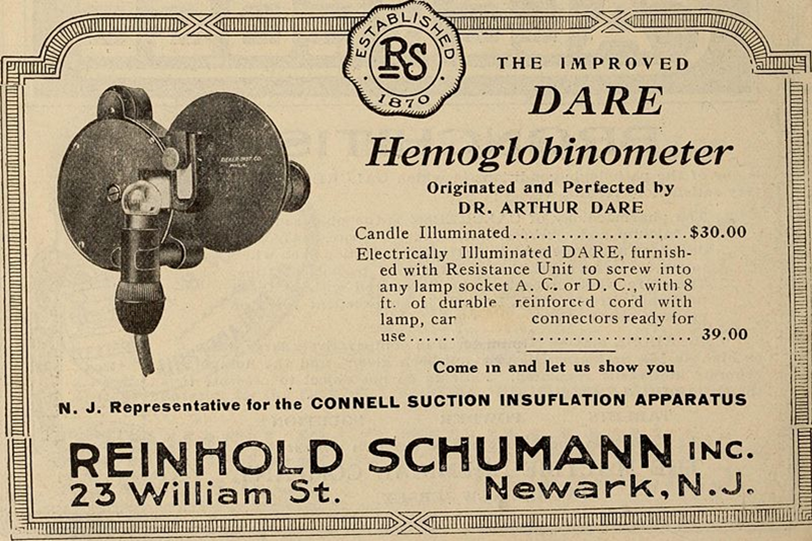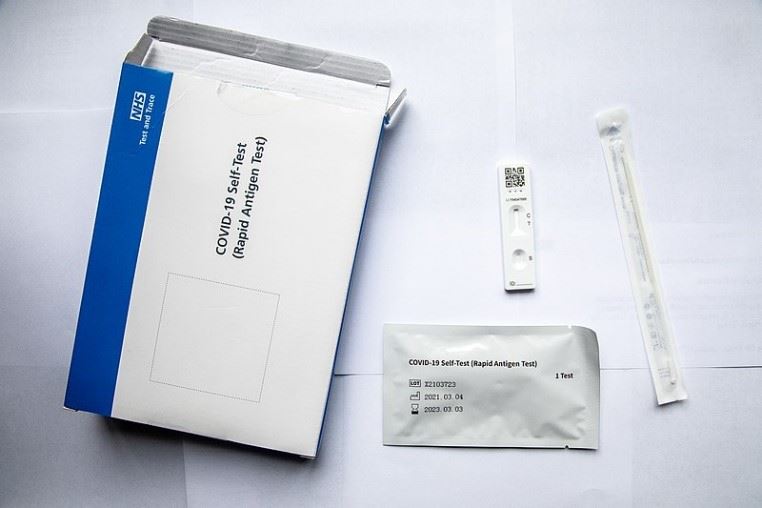 by Allison Reardon
by Allison Reardon
The collections of a museum often stretch much further than what could ever be displayed to the public, and even the artifacts that are exhibited can fall by the wayside due to the time restraints of a guided tour. Although these artifacts are sometimes overlooked in favor of other interesting objects on the tour, that doesn’t mean that they don’t also have important and interesting stories of their own. One such example is found in the clinical laboratory at the Indiana Medical History Museum. On the lab bench, surrounded by various other pieces of equipment, lies a small box with a velvet lining holding several small pieces of a medical device. (The lining of the device currently on display has faded to a tan color; a look at another version in the museum’s collection shows the beautiful original green velvet.) The box itself reveals the device’s identity: “The Dare Hemoglobinometer.” [Photo: Dare Hemoglobinometer on display at IMHM]
 The Dare hemoglobinometer is a device that was patented in 1922, and 100 years later, hemoglobinometers are still in use. Although modern examples would be unrecognizable compared to this artifact, they serve the same purpose: to determine the amount of hemoglobin (Hb), a protein that carries oxygen, in a patient’s blood. To operate the Dare hemoglobinometer, a physician would place a pipet with a patient’s blood sample in a portion of the device that lined up with a color scale; they would then compare the blood to this scale, indicating the percentage of Hb in the blood [1]. Many methods are available today for the same test, but similar examples are often digital. Digital hemoglobinometers are similar to the Dare hemoglobinometer because they are able to be used outside of a laboratory and read quickly, but these digital devices have many advantages, such as the fact that there is “no or minimal subjectivity in the estimation of Hb” [2]. Digital hemoglobinometers like TrueHb Hemometer and HemoCue® work through photometry rather than estimation by a physician looking through a lens [2]. [Photo: Another Dare Hemoglobinometer in the IMHM collection]
The Dare hemoglobinometer is a device that was patented in 1922, and 100 years later, hemoglobinometers are still in use. Although modern examples would be unrecognizable compared to this artifact, they serve the same purpose: to determine the amount of hemoglobin (Hb), a protein that carries oxygen, in a patient’s blood. To operate the Dare hemoglobinometer, a physician would place a pipet with a patient’s blood sample in a portion of the device that lined up with a color scale; they would then compare the blood to this scale, indicating the percentage of Hb in the blood [1]. Many methods are available today for the same test, but similar examples are often digital. Digital hemoglobinometers are similar to the Dare hemoglobinometer because they are able to be used outside of a laboratory and read quickly, but these digital devices have many advantages, such as the fact that there is “no or minimal subjectivity in the estimation of Hb” [2]. Digital hemoglobinometers like TrueHb Hemometer and HemoCue® work through photometry rather than estimation by a physician looking through a lens [2]. [Photo: Another Dare Hemoglobinometer in the IMHM collection]

[Photo: Advertisement for the Dare Hemoglobinometer showing the device set-up]
Although these disparate technologies are separated by a century, they serve similar purposes in the realm of healthcare. They are both examples of point-of-care tests, which are medical tests that do not need to be performed in a hospital laboratory. The unique qualities of point-of-care tests – including their small footprint and their speed of providing results – make them great candidates for use in low-income countries, and according to UNICEF, they “offer an unprecedented opportunity to reduce inequalities in health” [3]. Hemoglobinometers, including the artifact on display at the IMHM, can be held up as examples of point-of-care testing, and they are an essential part of solving the worldwide health issue of anemia. This medical condition, which occurs due to a low level of hemoglobin in the blood, affects “42% of children less than 5 years of age and 40% of pregnant women worldwide” and is most prevalent in low-income countries [4].
Anemia is not the only serious global health issue that can benefit from point-of-care testing. A more recent issue that has been put at the forefront of scientific research and discussion is the COVID-19 pandemic. At the beginning of the pandemic, people brought point-of-care testing into the conversation because it can allow for faster testing, which in turn helps to slow the transmission of the disease [5]. A September 2021 New York Times article explained that the U.S. was falling behind other countries in regards to this type of testing, and this “shortage of testing in the U.S. may be contributing to the virus’s spread” [6]. Of course, there are disadvantages to point-of-care and at-home testing for COVID-19. However, this Times article argues that the advantages may outweigh the disadvantages. Rapid tests do not have the same level of sensitivity as PCR tests (most often used in the U.S.), but some experts explain that they “do not need to be so sensitive to be effective” [6]. Like with anemia, researchers have also thought of these tests as a way to reduce health inequalities. COVID-19 has “disproportionately impacted people of color and under-resourced regions,” and point-of-care testing is a viable option for making testing faster and more accessible [5]. [Photo: NHS rapid COVID-19 test]
behind other countries in regards to this type of testing, and this “shortage of testing in the U.S. may be contributing to the virus’s spread” [6]. Of course, there are disadvantages to point-of-care and at-home testing for COVID-19. However, this Times article argues that the advantages may outweigh the disadvantages. Rapid tests do not have the same level of sensitivity as PCR tests (most often used in the U.S.), but some experts explain that they “do not need to be so sensitive to be effective” [6]. Like with anemia, researchers have also thought of these tests as a way to reduce health inequalities. COVID-19 has “disproportionately impacted people of color and under-resourced regions,” and point-of-care testing is a viable option for making testing faster and more accessible [5]. [Photo: NHS rapid COVID-19 test]
Point-of-care testing is an essential part of health care today that is actively discussed and improved in response to global health concerns – from anemia to COVID-19. As researchers look into point-of-care technology, a look back at some earlier examples of these tests can give us a more complete appreciation of their use and convenience. So, although the Dare hemoglobinometer in the clinical laboratory at the Indiana Medical History Museum may seem like a small, insignificant object in a room full of equipment, a closer look reveals that this point-of-care device foreshadows current healthcare solutions.
References
[1] “The Dare Hemoglobinometer.” Smithsonian’s National Zoo & Conservation Biology Institute. Accessed September 8, 2021. https://nationalzoo.si.edu/object/nmah_735248.
[2] Yadav, Kapil, Shashi Kant, Gomathi Ramaswamy, Farhad Ahamed, and Kashish Vohra. “Digital Hemoglobinometers as Point-of-Care Testing Devices for Hemoglobin Estimation: A Validation Study from India.” Indian Journal of Community Medicine 45, no. 4 (2020): 506-510. doi: 10.4103/ijcm.IJCM_558_19.
[3] Kirby, Rebecca, and Kara Palamountain. Target Product Profile: Hemoglobinometer – Point-of-Care Diagnostics. UNICEF, 2020. Accessed September 8, 2021. https://www.unicef.org/supply/media/2911/file/Hemoglobinometer-TPP-v1.pdf.
[4] “Anaemia.” World Health Organization. Accessed September 9, 2021. https://www.who.int/health-topics/anaemia#tab=tab_1.
[5] Valera, Enrique, Aaron Jankelow, Jongwon Lim, Victoria Kindratenko, Anurup Ganguli, Karen White, James Kumar, and Rashid Bashir. “COVID-19 Point-of-Care Diagnostics: Present and Future.” ACS Nano 15, no. 5 (2021): 7899-7906. https://doi.org/10.1021/acsnano.1c02981.
[6] Leonhardt, David. “Where Are the Tests?” The New York Times. September 21, 2021. https://www.nytimes.com/2021/09/21/briefing/rapid-testing-covid-us.html.
Image Credits
Image 1: Dare hemoglobinometer found in IMHM clinical laboratory, photo provided by author.
Image 2: Another version of Dare hemoglobinometer in IMHM collection, photo provided by author.
Image 3: Hemoglobinometer – Originated and Perfected by Dr Arthur Dare. Wikimedia Commons. 1920, https://commons.wikimedia.org/wiki/File:Hemoglobinometer_-_Originated_and_Perfected_by_Dr_Arthur_Dare.jpg.
Image 4: Jwslubbock. NHS Covid test pack and contents 2. Photograph. Wikimedia Commons.August 18, 2021, https://commons.wikimedia.org/wiki/File:NHS_Covid_test_pack_and_contents_2.jpg. (To view the license for this image, visit https://creativecommons.org/licenses/by-sa/4.0/deed.en)